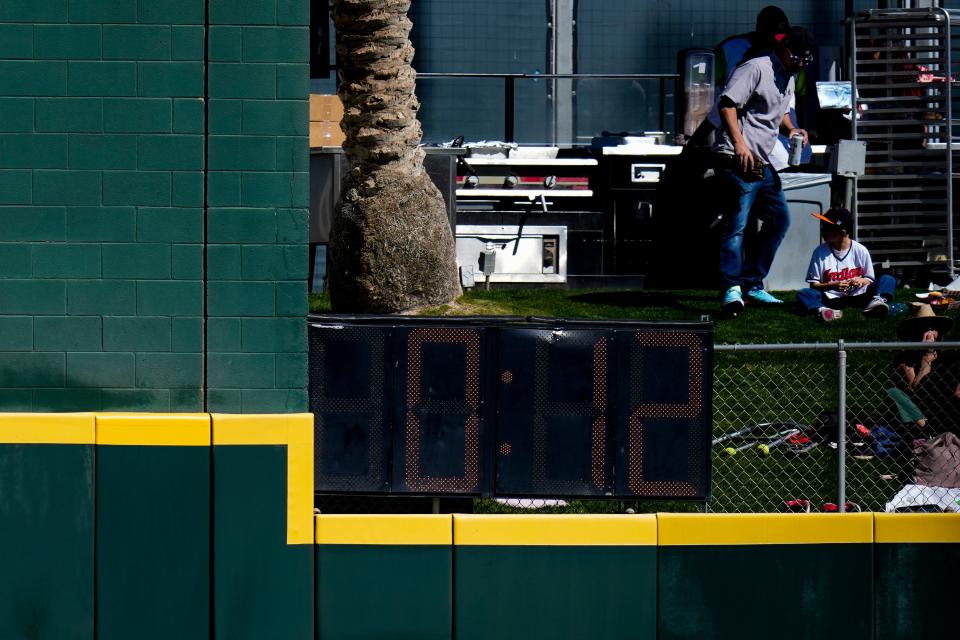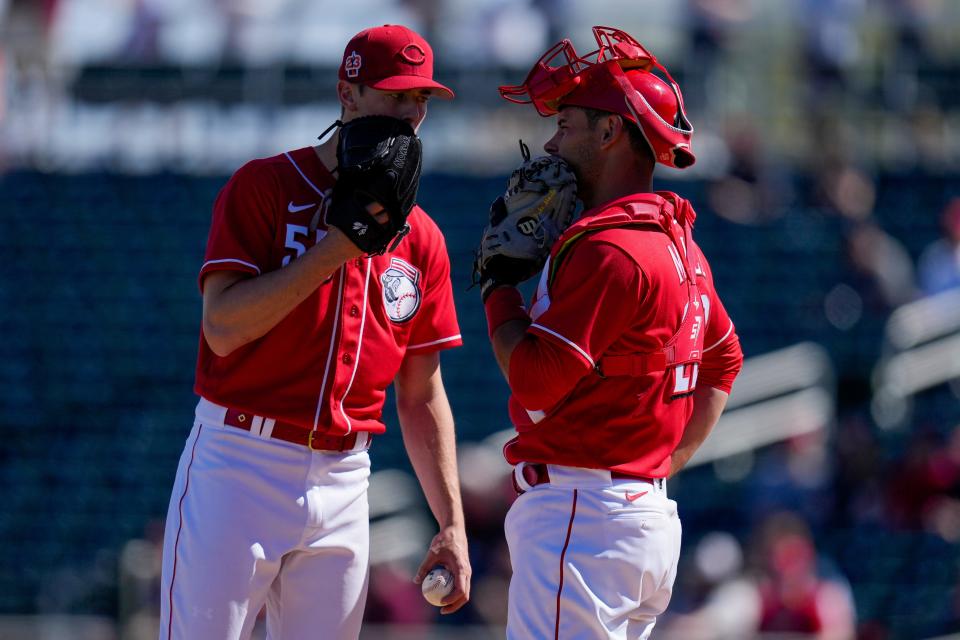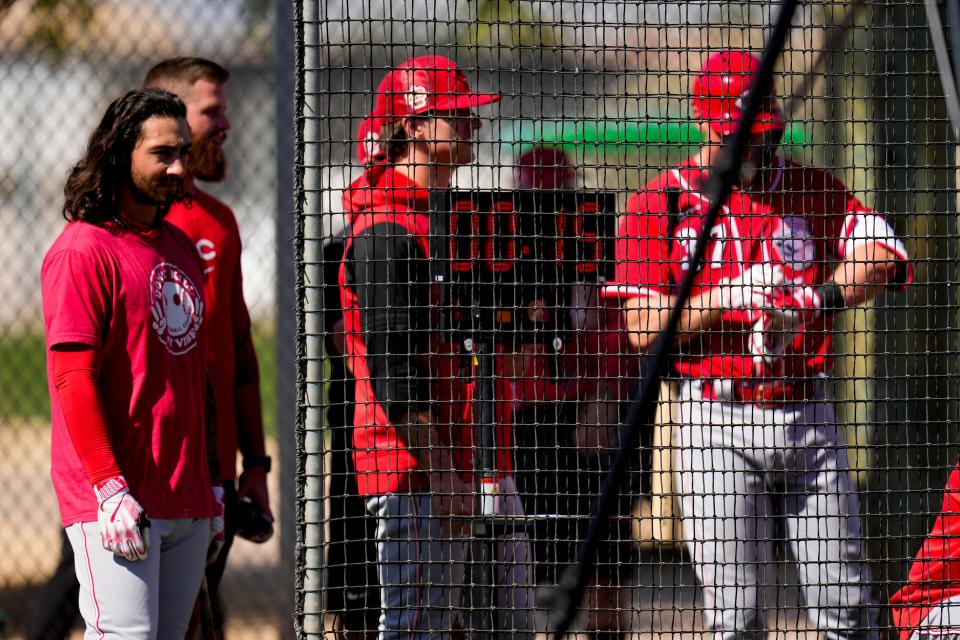'It was a little funky': Cincinnati Reds players adjusting to pitch clock nuances
GOODYEAR, Ariz. – The first game equipped with a pitch clock had the desired effect in the Cincinnati Reds’ Cactus League opener, but pitcher Buck Farmer and other players discovered some nuances that left them with questions.
During the fourth inning Saturday, Cleveland Guardians shortstop Brayan Rocchio hit a ground ball to first base. Farmer covered the bag for the out, then tossed the ball around the infield. By the time the ball worked its way back to Farmer and he was on the mound, there were 12 seconds left on the pitch clock.

The problem? Home-plate umpire Stu Scheurwater wasn’t even behind the plate after the previous play. Scheurwater put on his mask with nine seconds left and was moving baseballs into his pocket with five seconds remaining. Farmer didn’t want to risk a pitch clock violation, so he began his delivery at the same time Scheurwater signaled to restart the clock.
Reds spring training'He just gets it': Why Joel McKeithan was the right fit to be the Reds hitting coach
Reds spring game reportMatt McLain blasts walk-off homer as Cincinnati Reds win spring training opener
Reds spring trainingReds Xtra: An updated Opening Day roster projection as spring training games begin
“They are so dead set on starting the clock whenever the pitcher enters their circle with the ball,” Farmer said. “That operator (Saturday) had no idea the umpire wasn’t even behind the plate yet.”
Scheurwater had a long chat with Farmer and Reds pitching coach Derek Johnson at the end of the inning. It was a potentially dangerous situation because the umpire wasn’t ready for a pitch – it was a strike – and he didn’t want to stop Farmer in the middle of his delivery.
Need better understanding from clock operators
“That has got to be something the league needs to be better about and should’ve already crossed that bridge, especially with the clock operators,” Farmer said. “All these rules are just so set in stone that they are just like, hey, let’s jump into it. There weren’t a whole lot of things thought out. That was one of them where I was already on the mound, the clock started – it was at 12 – and the umpire is still walking back to home plate. I think stuff like that is going to be addressed because now it’s happened.”

The Reds were charged with two pitch clock violations during Saturday’s Cactus League opener. Jose Barrero wasn’t ready to hit with eight seconds remaining on the clock during his first at-bat, so he was given an automatic strike and started in a 0-1 count.
Lefty reliever Daniel Norris had two runners on base with two outs in the third inning, and he was given an automatic ball when the pitch clock expired as he looked at the runner on second.
“It was weird,” said Norris, who had no experience with a pitch clock. “It happened pretty quickly. I felt a little rushed, I guess, but you have to learn how to deal with it.”

Guardians Manager Terry Francona had a brief chat with Scheurwater from the dugout in the first inning when Reds catcher Luke Maile signaled signs to infielders in front of the plate with runners on first and third. Maile said he wasn’t sure if he had to complete his signs before the pitch clock dropped to a certain number between batters.
“Just like the variables, right?” Maile said. “A broken bat, do I go get the bat? Foul ball off the screen at one point, Buck comes up like halfway to the plate and I’m like, well, I’m not going to throw him the ball yet because then the clock is going to start, and he has to walk to the mound. It was a little funky. I would imagine umpire discretion is going to take over and eliminate that, but for now, we don’t really know.”
Reds spring trainingBreaking down the trio of top shortstop prospects in Reds' big league camp
Reds spring training'That shouldn't affect me': Reds shortstop Jose Barrero putting 2022 struggles behind him
A crazy ending in Atlanta's game
A lot of players were talking about the ending in Atlanta’s spring training game against Boston. The situation was bases loaded, two outs, full count in the bottom of the ninth inning with the score tied. Fans were on their feet and clapping. Atlanta’s hitter, Cal Conley, was in the batter’s box, but he was tapping his bat on the plate and wasn’t looking at the pitcher with seven seconds remaining on the pitch clock.
The home-plate umpire, John Libka, ruled it was a clock violation and Conley struck out to end the game in a tie without a pitch being thrown.
“That’s where I think the line should be drawn,” Farmer said. “The game shouldn’t be dictated on something like that. I think there has to be a little bit of feel there. Either that or in the ninth inning, no matter what, I think the clock should go up to 20 seconds or something like that. I don’t think raising the clock by five seconds for one inning is going to change a whole lot.”

It’s one thing when a spring training game is decided by a pitch clock violation, but there will likely be a Major League game decided in the ninth inning because of it.
“That’s what the fans want is drama,” Farmer said. “That was pretty bad because the fans didn’t get to see how the game was going to play out.”
Reds spring trainingA breakdown of the pitchers competing for 2 spots in the Cincinnati Reds' rotation
Reds spring trainingCincinnati Reds spring training 2023 schedule
MLB reported the average time of spring training games, through Saturday, was two hours and 36 minutes with 1.79 pitch clock violations per game, according to the Washington Post. It’s 25 minutes faster than the average spring training game time last year.
The Reds finished their spring training game in two hours, 23 minutes. It would’ve been their second-fastest game last spring.
“The overall pace was quicker,” Reds Manager David Bell said. “It was nice. It was a nice pace. It wasn't rushed but it just kept everything moving.”
This article originally appeared on Cincinnati Enquirer: Cincinnati Reds players say pitch clock was 'a little funky'

